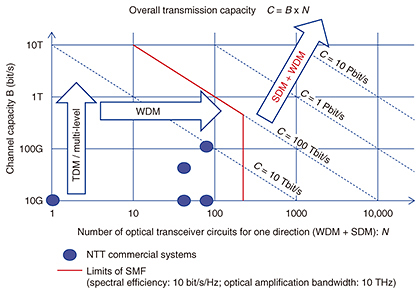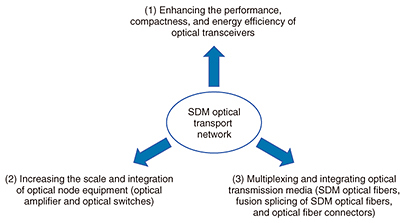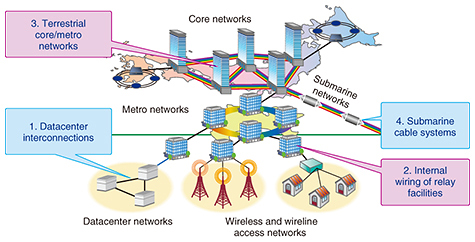 |
|||||||||||||||||||||||||
|
|
|||||||||||||||||||||||||
|
Feature Articles: State-of-the-art Space Division Multiplexing Technologies for Future High-capacity Optical Transport Networks Vol. 15, No. 6, pp. 1–7, June 2017. https://doi.org/10.53829/ntr201706fa1 Space Division Multiplexing Optical Transmission Technology to Support the Evolution of High-capacity Optical Transport NetworksAbstractThis article describes high-capacity space division multiplexing (SDM) optical transmission technology to support the evolution of broadband networks. A new spatial degree of freedom is introduced in optical transmission systems, optical node equipment, and optical fibers to overcome the physical limits of today’s single-mode fiber based systems. Future SDM-based optical networks will achieve high capacities of over 1 Pbit/s in a single strand of fiber, a 100-fold increase in capacity, and node throughputs of more than 10 Pbit/s. Keywords: spatially multiplexed optical communication, petabit-per-second optical communication, multi-core multi-mode fiber 1. IntroductionIn recent years, the Internet has become an indispensable infrastructure offering broadband services such as video streaming and electronic commerce in support of daily life. Much effort is being devoted in mobile communications to develop 5G (fifth-generation) services, which will achieve low latency with large bandwidths in excess of 10 Gbit/s. The emerging IoT (Internet of Things) technologies based on the future network infrastructure are expected to enable new services that will be as ubiquitous and essential as the air around us. The evolution of core and metro optical transport networks in NTT Group companies is shown in Fig. 1. The basic transmission medium of these networks has so far been single-mode fiber (SMF), which has only one waveguide (core) with a single waveguide mode per strand of optical fiber. In the NTT laboratories, we have been conducting timely research and development (R&D) on a state-of-the-art optical transport system that economically realizes the required transmission capacity. Our contributions have attained an increase in capacity of almost 5 orders of magnitude over the last 30 years (doubling every 2 years).
The digital coherent system [1] has been implemented in NTT’s commercial network. Not only does it improve receiver sensitivity and spectral efficiency, but it can also greatly improve the compensation capability of distortion characteristics such as chromatic dispersion and polarization mode dispersion of optical fibers. Transport systems with 10-Tbit/s-class-capacity transport systems have been installed in commercial networks by using a polarization-division-multiplexed quadrature phase-shift keying (PDM QPSK) modulation format and the typical 50-GHz wavelength division multiplexing (WDM) spacing. We have also confirmed the feasibility to upgrade to optical networks with a capacity of 20 Tbit/s per fiber and a channel capacity of 400 Gbit/s in the field. To achieve this, we employed twin-subcarrier multiplexing and high-speed digital signal processing techniques based on 16-quadrature amplitude modulation (QAM)*1 [2]. In laboratory experiments, we demonstrated the record transmission capacity of 102 Tbit/s across a single SMF by using the subcarrier multiplexed PDM 64-QAM format [1]. Furthermore, we can significantly improve the scalability of optical networks without electrical signal regeneration by introducing reconfigurable optical add/drop multiplexer (ROADM) nodes. The above-mentioned 100-Gbit/s digital coherent channels are implemented in the existing high-capacity optical networks with multi-degree ROADMs, where the 100-Gbit/s channels can be set at arbitrary wavelengths and arbitrary directions (Fig. 2).
Efforts to increase the capacity of conventional SMF-based optical communication systems beyond 100 Tbit/s while keeping the same repeater spacing as the conventional network have reached or exceeded the ultimate physical limit of SMF (the so-called capacity crunch) due to the fiber nonlinear effect*2 and the fiber fuse phenomenon [3, 4]. Furthermore, in future optical node systems, several fundamental technologies such as highly integrated optical switching and high-density wiring and connectors will be required in order to substantially improve node throughput in step with the increases in transmission capacity. We have conducted extensive R&D on space division multiplexing (SDM) optical communications that can offset these limiting factors and thus achieve further increases in both transmission capacity and optical node throughput [3–5]. In this article, we review the current status and the future prospects in this field. We present recent activities in the NTT laboratories involving SDM optical communications technologies that demonstrate over 1-Pbit/s long-haul transmission performance, and a potential optical switching node system with node throughput of more than 10 Pbit/s.
2. Overview and benefits of SDM optical communications system technologyAn overview of an SDM optical communications system is shown in Fig. 3. The principal components of this system are the SDM optical transmission medium, SDM nodes with optical amplification and ROADM functions, and an SDM integrated optical transceiver. Typical candidates for the optical transmission medium of an SDM optical transmission system are shown on the left side of the figure. A set of conventional SMFs used as the SDM optical transmission medium is shown in Fig. 3(a), and a multi-core fiber (MCF) consisting of multiple cores in a single optical fiber is shown in Fig. 3(b). A multi-mode fiber (MMF) that uses different modes to transmit different signals across the single core is depicted in Fig. 3(c).
In high-capacity SDM node systems, spatially multiplexed WDM signals (SDM/WDM signals) are simultaneously amplified and transmitted to achieve an economical long-haul transmission system. Any channel can be sent to an arbitrary wavelength in an arbitrary direction (the typical number of directions is eight) without the need for optical-electrical conversion. The optical node system exemplified by Fig. 3(a) can effectively utilize the existing SMF infrastructure and achieve flexible accommodation of traffic demands in the short term. The multiplexing structures of existing optical communications systems and future SDM optical communications systems are compared in Fig. 4. In existing SMF-based commercial systems, the channel capacity has been increased up to 100 Gbit/s by means of time division multiplexing (32 Gbaud) and multi-level coding (QPSK). The typical WDM channel count N is around 100 in today’s SMF-based systems (i.e., N is the number of multiplexed optical transceiver circuits). The WDM signals are simultaneously amplified and transmitted through several optical inline amplifiers and optical nodes. Such configurations achieve economical high-capacity long-haul transmission systems with an overall transmission capacity (C = B × N) of 10 Tbit/s.
The available number of channels in a conventional WDM system is determined by the signal bandwidth of optical amplifiers, roughly 4–5 THz in the C band or L band, or up to about 10 THz if the two bands are used in parallel (C and L bands). Practical high-capacity systems have been implemented by installing hundreds of high-speed optical transceiver circuits in a limited equipment space without excessive power consumption, making full use of the available optoelectronic device performance. Multi-level modulation can improve the spectral efficiency (SE) and thus increase the channel capacity. However, we have to consider the trade-off between SE and transmission distance if we are to maintain backward compatibility with the existing system. It is possible to increase the channel capacity up to 200 Gbit/s by enhancing the SE up to 4 bit/s/Hz with medium transmission reach through the use of PDM 16-QAM signals. However, the transmission distance is severely limited if the SE is increased up to 10 bit/s/Hz by using a higher-order QAM format [1]. Therefore, when considering channel capacities beyond 400 Gbit/s, the combination of subcarrier multiplexing and/or a high symbol rate is a potential solution, while keeping the existing order of the QAM format low so as to ensure long transmission reach. Since the SE does not increase with this strategy, this naturally requires that the channel bandwidth increase in proportion to the channel rate. As a result, the number of WDM channels accommodated in the typical optical amplifier bandwidth naturally decreases, as shown in Fig. 4. Because the channel capacity growth rate (increasing roughly tenfold over 20 years) is more gradual than the total capacity growth rate as shown in Fig. 1, we have to effectively combine SDM and WDM technologies to ensure the same number of optical channels as before. Therefore, if future ultra-high-capacity SDM transmission systems are to have a total capacity C of more than 1 Pbit/s, the required number of optical transceiver circuits implemented will increase to 10 and even 100 times that of a conventional SMF system. Thus, SDM technologies such as scalable integrated optical switching nodes as well as compact integration of optical transceiver circuits are the key to realizing economical high-capacity SDM optical transport networks. 3. Core technologies of SDM optical communication infrastructureIn the Feature Articles in this issue, we describe the current state of R&D and the future prospects of SDM optical communications technologies from the following three key aspects (Fig. 5).
(1) Enhancing the transmission performance, compactness, and energy efficiency of optical transceivers (transmission equipment) (2) Increasing the scale and integration of optical node equipment (optical amplifier and optical switches) (3) Multiplexing and integrating optical transmission media (SDM optical fibers, fusion splicing of SDM optical fibers, and SDM optical fiber connectors) Transmission equipment (1) involves general technologies for both conventional SMF-based optical communications systems and future SDM optical communications systems. In one Feature Article, we describe the impact of inter-core crosstalk characteristics and efficient digital signal processing in terms of realizing spatially multiplexed long-haul optical communications systems [6]. We also explain the feasibility of petabit-per-second-class long-haul transmission. In a high-capacity SDM optical transport network, the number of multiplexed optical transceiver circuits will be one or two orders of magnitude higher than that of the conventional SMF-based system. Therefore, to realize an economical high-capacity energy-efficient optical network, it is very important to increase the transmission reach without optical-electrical conversion in the optical node, since reducing the number of optical transceiver circuits is critical for reducing the total system power consumption. With regard to SDM node technology (2), the final target is to increase the throughput of optical nodes by over 100 times and to improve the transmission capacity to more than 1 Pbit/s. For this purpose, we have introduced novel optical node architectures and novel device integration technologies in SDM optical amplifiers and SDM integrated optical switches. We describe the recent R&D activities in this field [7, 8]. Finally, with regard to multiplexing and integration of optical transmission media (3), we describe the issues and feasibility of optical fiber transmission media for dense SDM (DSDM) with the SDM levels of 30 and beyond. We describe the current state of MCF, MMF, and multi-core multi-mode fiber (a combination of both) [9], as well as the connection devices between new SDM fibers and existing SMF and splicing techniques and connector technology for new SDM fibers [10]. The NTT laboratories have been commissioned by organizations including the Ministry of Internal Affairs and Communications of Japan and EC Horizon 2020, and the National Institute of Information and Communications Technology to accelerate our R&D in this field [4, 5]. 4. Future prospectsThe application areas where the future SDM optical communications system is expected to be applied are shown in Fig. 6. There is strong demand for short-distance applications such as datacenter interconnections and the internal wiring of SDM network elements in terms of compactness and low-power operation. Such applications have great potential in this field.
For medium-term SDM system application in terrestrial core/metro networks, it is promising to consider an SDM system that effectively uses existing installed SMF fiber cables as shown in Fig. 3(a). Furthermore, the use of high-capacity SDM optical fiber cables is expected to support the implementation of economical core/metro high-capacity optical networks with a capacity of more than 1 Pbit/s, as it will promote standardization and practical applications. In ultra-long-haul submarine cable systems that must accommodate the traffic growth of international communications, SDM optical communication technology is expected to offset the capacity crunch of conventional SMF-based systems and power supply constraints (i.e., power crunch), both of which are critical constraints in ultra-long-haul submarine cable systems. References
|
|||||||||||||||||||||||||
















